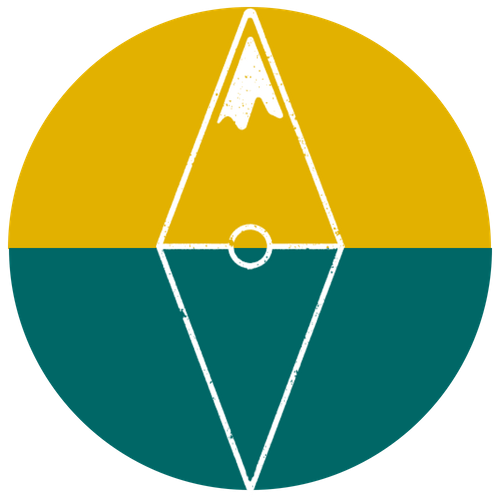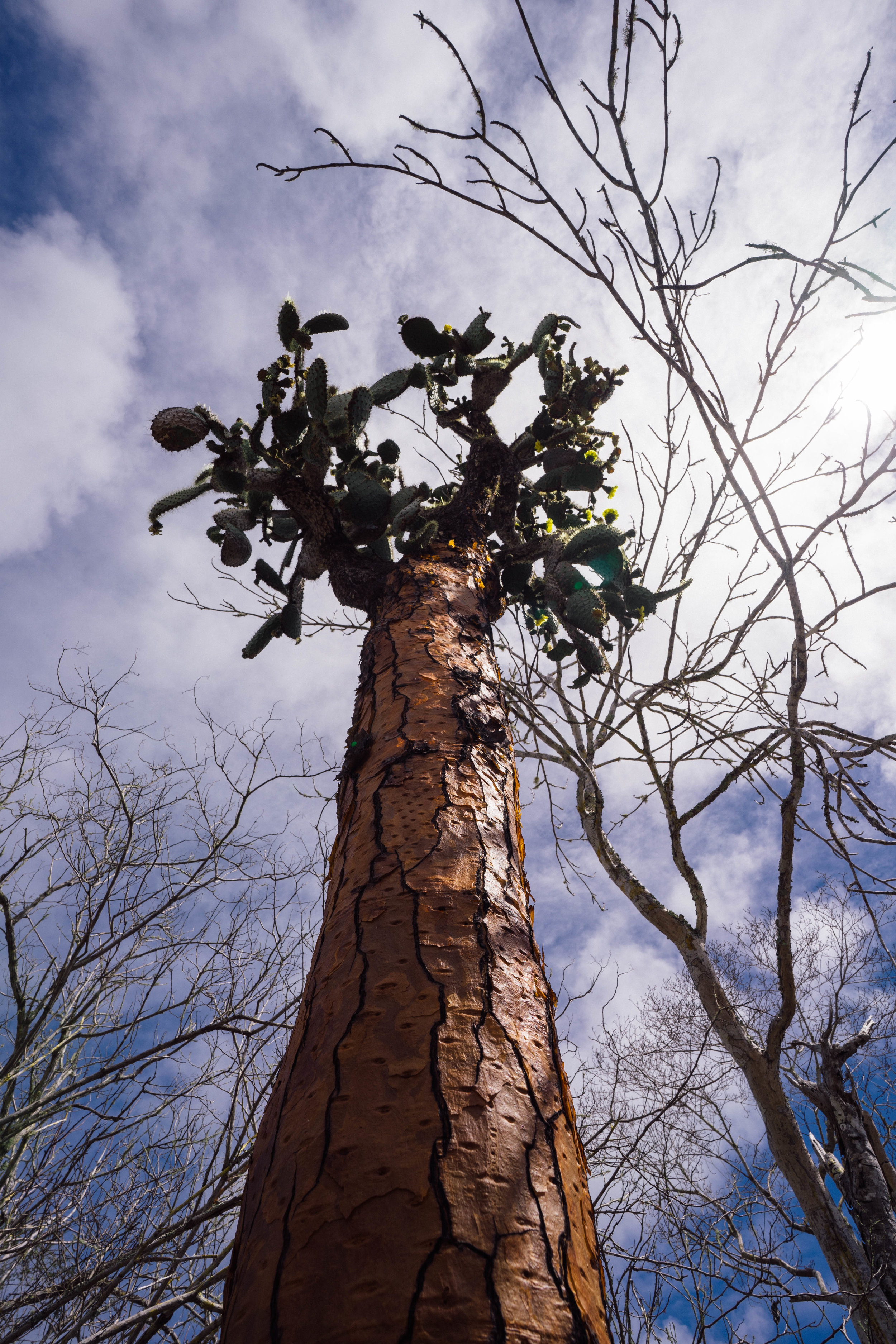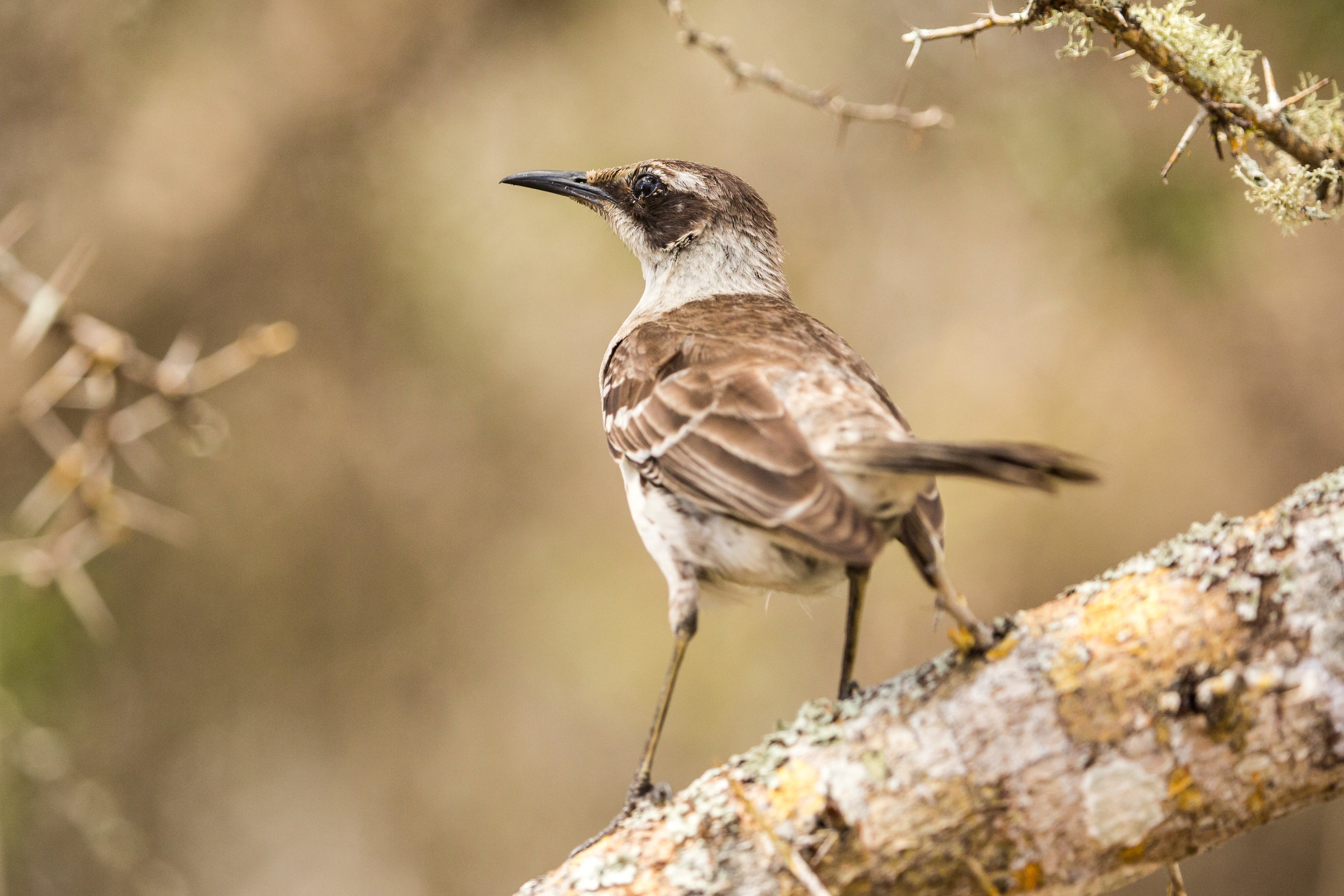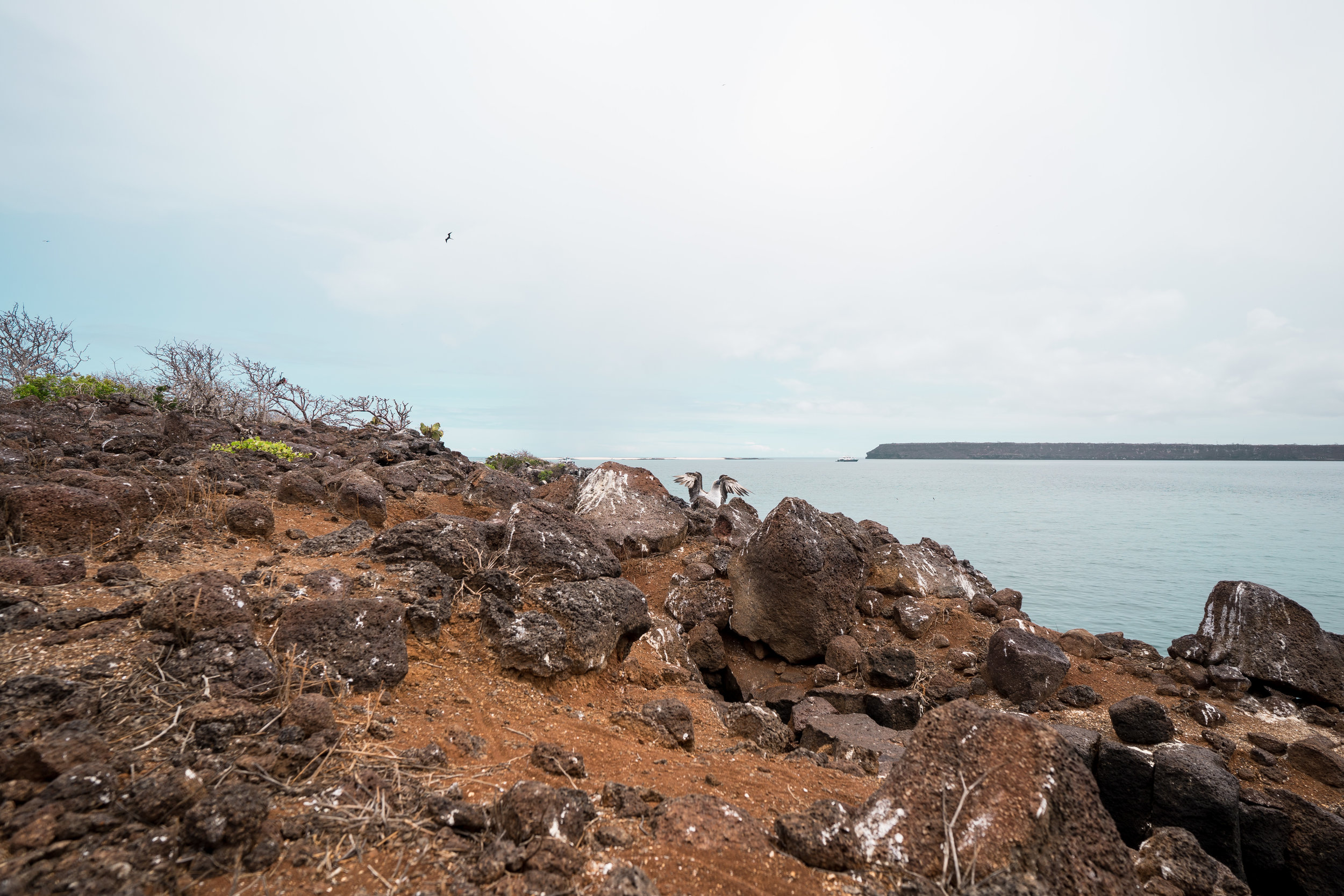VISITING SANTA CRUZ: Wildlife in Galápagos’s Tourism Hub
Text: Andreea Lotak; Photos: Andreea & Justin Lotak · 12 min read
Sally Lightfoot crabs at Las Bachas Beach on the north side of Santa Cruz Island, Galápagos
One late afternoon on the third day in the archipelago, the Coco de Mer entered the Academy Bay in Puerto Ayora, Santa Cruz. We had arrived in the largest town of the Galapagos where visitors, tour operators, service providers, locals and wildlife were all trying to coexist.
Puerto Ayora is a true experiment of conservation living alongside tourism and overpopulation. With around 12,000 inhabitants and a constant rush of visitors, the town has had and still has many troubles, from water quality to disposing of the plastic trash seemingly always present near humans. Upon getting dropped off at the dock by a water taxi, we were greeted by a similar sight as in San Cristobal with sea lions taking over benches and rocks for an afternoon nap, marine iguanas swimming around, crabs chasing each other and the occasional black-tip shark and rays looking for a meal. We took that as a sign that in spite of the boat traffic in the bay, wildlife is still coming here to share space in this environment altered by humans.
Like with Puerto Baquerizo Moreno on San Cristobal, we found the town charming with its architecture, colors, vegetation and cleanliness. Anticipating this being a prime tourist destination we were expecting to find a large crowd of people strolling along the main avenue at a slow pace, almost suffocating one another. It wasn’t the case. It actually wasn’t the case anywhere during our entire Galapagos experience, even though December-January is one of two peak seasons for visiting the archipelago. Part of the plastic invasion has been kept in check since 2006 when an environmental education and recycling center was inaugurated, followed by community outreach programs to encourage people to properly dispose of their waste. Currently it seems that some 40% of the waste is recycled and reused on the islands to make paving stones, souvenirs, bags or compost among other things. Here, as on San Cristobal, there is the ever-present message to conserve and protect the uniqueness of the Galapagos and its fragile environment, while the largest part of the territory is set aside for the national park and kept free of urban or rural development.
As is the case with many places on Earth, authorities, park officials and NGOs are struggling to manage environmental damages that started long time ago, with a great focus on invasive species that are outcompeting the endemic ones. The main offices of the national park are located in Puerto Ayora, next to the headquarters of the Charles Darwin Foundation and its extensive tortoise breeding center. Located a short 10-minute walk from downtown along the coastal avenue, these are free-of-charge attractions where one can take the opportunity to better understand the Galapagos Islands and its unique species and history. Also, getting familiar with the work of the Charles Darwin Foundation might inspire one to contribute with a direct donation or by purchasing items from their store which benefit conservation efforts in collaboration with the national park. This was a several-hour visit for us, as we also had the chance to sit down and talk to Cristian Sevilla, the head of the conservation program within the national park. The result of this interview and of what we've learned will be up on the blog very soon.
TORTUGA BAY — ONE OF THE MOST SPECTACULAR BEACHES WE’VE SEEN
After visiting the park's headquarters and the Charles Darwin Foundation, we took a taxi that dropped us off at a trailhead located almost on the opposite end of town. This would wind its way to the Tortuga Bay (open 6:00 am - 6:00 pm daily), through the sunburned vegetation of Opuntia cacti and thorny bushes from where finches and intrigued Galapagos mockingbirds would check us out. It’s about a one hour walk which, if done in the middle of the day as we did, can be very hot and uncomfortable. But it is worth it. Eventually this dense vegetation bordering the paved trail opens up to an amazing white-sand beach with turquoise waters rivaling those of the Caribbean. The added bonus were the large marine iguanas strolling on the beach or swimming adjacent to curious humans, reminding visitors that this landscape is unique to the Galapagos.
Heading east toward a small and crowded lagoon on the beach we saw a few black-tip sharks swimming in the crystal water alongside many humans. Following the trail to a larger lagoon we passed another eerie Opuntia cactus forest rising above the lava bed. Taking shelter from the sun under a tree on the beach, we were greeted by a pair of funny Common cactus finches inquiring about those lenses we kept pointing at them. As we began to notice, this species of finch almost always seemed to be found as a pair: a gray female and a black male. And they also always seemed to be curious. They, too, can only be found in the Galapagos.
LAS GRIETAS
This is another amazing nature spot that is cost-free in the Galapagos. To get to Las Grietas (open 6:00 am - 6:00 pm, daily) one has to take a very short, 80 cents/person water taxi ride across the Academy Bay and walk for approximately 20 minutes through a similar flora and fauna as that of the trail to Tortuga Bay. The difference is made by the pink salt lakes where locals harvest the crystals. Since this is a free-of-charge place of dramatic beauty, the experience will be shared with quite a lot of visitors, unlike other more protected places in the Galapagos. But it is still worth the swim in the cold, refreshing waters. With snorkels, one can stare into the endless depth of the canyon and then rise above the water to find the same walls soaring toward the sky. One of the several paved trails available leads to a nice overlook of the bay and the town. Since this is an activity we can do without a guide in a fragile environment, taking responsibility for our actions is truly important. Staying on the path is crucial to protect vegetation, insects and birds' nests. We should not let the urge of getting to a better vantage point take us off the trail. Leaving no trace or picking up any piece of garbage if found protects this place that sees an important number of visitors each day. When swimming or snorkeling, an environmentally-friendly, organic sun protection keeps pollution out of the water so that turtles and sharks can keep coming to this canyon.
Beside these options there are still more things to do for a rather small expense in the highlands of Santa Cruz. Since these activities, which include a visit to the Los Gemelos/The Twins sinkholes, a Giant tortoise reserve and a beautiful hike up the highest peaks of the island take up almost an entire day, another blog post is dedicated to this specific experience.
Although a lot can be seen from exploring the places mentioned above or during a stroll through the towns of Baquerizo Moreno, Puerto Ayora, or Puerto Villamil on Isabela, in order to truly discover the wildlife treasures of this archipelago, one must hop onto one of the many rather expensive day tours. We discovered that the average cost for day trips to other uninhabited islands or for snorkeling off their coasts is somewhere around $150/person. Though at first it might seem like a let-down, having to spend this money to be crowded in a small bus with a group of people, we also learned that this is part of the management strategy of the park. All tours are coordinated daily and come with a naturalist guide, and the number of people at a given time at a specific location is limited. This way, although you’re surrounded by your group of maybe 12 people, there’s seldom anyone else in one given area. Hiking on the uninhabited islands is also limited to usually an hour so that other tours can come through without too much disturbance to wildlife.
A Visit to the North Seymour Island
Having booked a half-day tour to this island known for its large colony of frigatebirds and for opportunities of spotting other iconic wildlife like blue-footed boobies and Galapagos land iguanas, we set out early in the morning with a small bus accompanied by a guide. The first stop included in the tour was a one-hour snorkeling trip to the Bachas beach on the north side of Santa Cruz. Though the water had limited visibility and was fairly cold, we saw several green turtles swimming in the blue-green waters. These beaches are a place where they come on land to nest, and there were plenty of colorful coral fish, rays, and even sharks.
However, the highlight is the short hike along a path on the uninhabited North Seymour island. Upon arriving we saw a female sea lion that had very recently given birth to a loud little pup and she was working hard to keep him from falling off the cliffs, under which sharks were already patrolling.
Soon after we spotted some Blue-footed boobies doing their famous dance, bright yellow land iguanas and the frigatebirds dominating the fauna of the island. The landscape itself has an eerie beauty of trees with twisted branches, whitened by the guano of all these loud birds making their homes on top of them. We witnessed a pair of Magnificent frigatebirds up close displaying their courtship in full swing. Males with inflated, red pouches were flying around or resting on branches trying to attract the attention of the numerous females.
This place is an outstanding wildlife hotspot with so much to see and experience up close that it’s been so far unmatched by anything else we’ve seen. The guide was careful explaining that we must not linger for too long in one spot, as human presence has already been noted to deter some of the birds from nesting close to the path. The colorful ground vegetation of the island received the same attention and we were kindly asked to avoid stepping on it or wandering off the set path. Although this feels like such a controlled experience, different than the more adventurous type of nature immersion we usually seek, it was also one of the most rewarding in terms of the amount of wildlife seen. While on the way back we noticed that another group had arrived, so it was time for us to get off the island so that they could enjoy a more solitary hike as well. All in all it’s a system that puts wildlife as the primary concern, rather than tourists, but it’s the way it should be. And a lot can still be improved, including a slower pace for the boats that take tourists up to these islands to minimize impact on the marine wildlife to the detriment of time spent doing just one activity. Given the uniqueness of these islands, it depends on us as visitors to not impose or demand too much of service providers, which in turn forces them to give less attention to the wellbeing of flora and fauna. The experience is limited in terms of comfort, solitude or adventure, but pays off in outstanding opportunities of being in the presence of iconic animals, even if for a short amount of time. If you don’t have a true passion for seeing unique wildlife in a more remote habitat, consider enjoying only the inhabited islands where most of the Galapagos fauna can be seen as well, therefore saving money and reducing traffic to these remote nature paradises.
For a more adventurous activity though, consider diving. These dives are operated on the same basis of limiting the number of persons in one place at one time, and therefore they too are rather expensive (an average of $180/person). Justin dove at Gordon Rocks and talks about this experience in a separate blog post as part of the diving in the Galapagos story, which also includes excerpts from our interview with Mathias Espinosa from Scuba Iguana. As with North Seymour, it is an incredible opportunity of being close to wildlife you only thought you’d see in documentaries. Alternatively there are snorkeling day trips which seem to be also rewarding and cheaper than diving (average of $120/person).
Santa Cruz was the place where we got to learn a lot more about the conservation efforts on the islands and where we witnessed how human habitation and tourism are coexisting with a fragile ecosystem. Like on San Cristobal, marine iguanas, crabs, pelicans, herons, sea lions, rays, small sharks, and a wide variety of seabirds could be seen on a regular basis during a stroll through town. It’s a beautiful place with a mission to preserve a unique world heritage while handling economic development for its small human population. With a calm rhythm of life and a strong economy due to tourism, it’s easy to understand the draw that causes many Ecuadorians to move to the islands. However, keeping the growth of the population under control and finding better ways to receive a constant flux of visitors while protecting the ecosystem remain key issues for the conservation of this amazing place.























"We call Galapagos a ‘social ecosystem’ - the union of the community with the ecosystem’s management, which is what generates conservation." Interview with Christian Sevilla, responsible for the Conservation and Restoration of Island Ecosystems department within the Galapagos National Park.
Intact ecosystems and their continuous conservation are something that an increasing number of people are willing to pay to witness, and whether for their endemic species, evolutionary importance, or rich biodiversity, many islands around the world claim to be different regions’ “Galápagos”.
"When you go to dive you have privacy and the fishes have peace, and you don't have a 'New York' underwater." Interview with Mathias Espinosa, co-founder of Scuba Iguana, the oldest operating dive company on Santa Cruz Island.
We were greeted by pristine, blue and shallow waters filled with marine life, while the unpaved streets of the town promised a more quiet experience than the one on San Cristóbal or Santa Cruz.
From the boat anchored in Academy Bay I would look up every morning at the silhouette of Cerro Crocker, the highest peak on the island. Soon I’d be making my way up there, escaping the dryness of the coast for which Galapagos is famous.
Visiting the Santa Cruz Island with its budget-friendly options, conservation hot-spots and the incredible day trip to the Seymour Norte island.
It had been six days of open ocean when one early morning we woke up with land in sight. From the misty air and foggy, rugged landscape of what looked like a barren island it was easier to think we had reached some mysterious lands up North rather than at the Equator. Once we sailed past the majestic silhouette of the Leon Dormido rocks it was less than an hour that we’d make our entrance in the bay of Puerto Baquerizo Moreno, San Cristobal.
We arrived to the Galapagos Islands by sea, following a similar trajectory that many of the species that call these islands home may have taken tens of thousands of years ago.